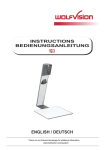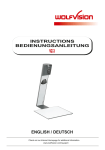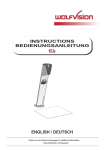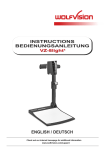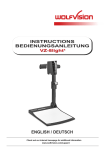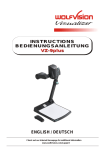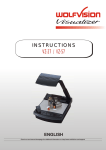Download WolfVision VZ-3
Transcript
R INSTRUCTIONS VZ-3 ENGLISH Check out our Internet Homepage for additional information www.wolfvision.com/support ENGLISH Precautions WARNING! Risk of electric shock Dangerous voltage inside Please observe the following: Use this Visualizer only with the correct voltage as shown on the type label ! Do not expose the Visualizer to heat or moisture ! Protect the Visualizer from excessive shocks ! Make sure that sufficient air circulation for cooling the Visualizer is possible (ventilation slots on the back of the tube)! If there is any abnormality (abnormal noise, smell, smoke etc.) disconnect the Visualizer from mains immediately and contact your Visualizer dealer! Do not use a damaged power supply / power cord. This may cause short circuits or electrical shocks! To prevent danger, do not modify the Visualizer or operate without the cover panel firmly in place! Do not expose the Visualizer to water, metallic objects or any flammable material. Avoid installing the Visualizer in locations exposed to strong magnetic fields or electrical currents. Avoid installing the Visualizer in environments where there is radiation. This could cause monitor image distortion or damage to the CCD camera. Do not pull the plug from the power socket with wet hands! If the Visualizer is not used for a long time, disconnect it from mains! The external power supply has to be approved by CSA or UL in accordance to CSA 22.2-60950 or UL 1950. Precautions for LED light according EN62471: LED lightning system - Do not stare into beam! Do not modify the LED lightning system! Do not view the light beam with optical instruments! Ne pas regarder dans l'objectif lorsque le visualiseur est en marche! CODES - Short Keys One Push White Balance: Press the LIGHT key for 2 seconds to perform one push white balance. Activating the on-screen menu: Keep the MENU key (EXTERN) pressed for 2 seconds to activate the on-screen menu. Use the navigation keys (FREEZE and EXTERN) or the ZOOM wheel to navigate and the ENTER key (POWER) and the Selection keys (LIGHT and FOCUS) to enter submenus and to change values. For the help function, keep the HELP key (FREEZE) pressed for 2 seconds. Manual Focus: Keep FOCUS key pressed for 2 seconds and focus with the FREEZE and EXTERN keys. Press the FOCUS key quickly to return to normal operation mode. Reset Resolution to AUTO: Press FOCUS and LIGHT keys simultaneously and the Visualizer selects the best resolution for the connected display device. 1 Approval Marks on the unit: C Tested to complywith FCC standards for home or office use US L I ST E D 9902476 FCC information: This device complies with part 15 of the FCC rules. Operation is subject to the following two conditions: (1) this device may not cause harmful interference, and (2) this device must accept any interference received, including interference that may cause undesired operation. Note: This equipment has been tested and found to comply with the limits for a class A digital device, pursuant to part 15 of the FCC rules. Information to user: The user manual or instruction manual for an intentional or unintentional radiator shall caution the user that changes or modifications not expressly approved by the party responsible for compliance could void the user's authority to operate the equipment. This product is built according to Directive EMC and to Directive electrical equipment. Inspections, tests and evaluation are according to UL 60950. CSA 22.22-60950 Inspections, tests and evaluation are according to the CB-Scheme Inspections, tests and evaluation are according to the PCT-Scheme Copyright Information Copyright © by WolfVision. All rights reserved. WolfVision, Wofu Vision and are registered trademarks of WolfVision Holding AG, Austria. No part of this document may be copied, reproduced, or transmitted by any means, without prior written permission from WolfVision. Except documentation kept by the purchaser for backup purposes. In the interest of continuing product improvement, WolfVision reserves the right to change product specifications without notice. Information in this document may change without notice. Disclaimer: WolfVision shall not be liable for technical or editorial errors or omissions. The units are "MADE IN EU/AUSTRIA” Printed in Austria, August 2012 2 Components of the Visualizer ZOOM #4 R VISUA LIZER VZ-3 #3 #2 #1 #1 #2 #3 #4 Working surface (see page 7) Connectors (on the back behind the cable cover - see below) Light (maintenance-free LED) Control keys (see next page) Zoom wheel (see next page) Connectors (#2) #7 #6 EXTERN IN USB #8 LAN (PoE+) #5 DVI #5 #6 #7 #8 #9 DVI-I output (see page 8) USB port (see page 7) External Input for Computer RGB-signals (15pin) (see page 9) LAN port 10/100 TBase (see page 7) Power connection PoE+ (see page 7) Cable Tie to fix all cables (to unfasten, pull the lug) 3 #9 Control Keys (camera head) (#4) One of the great features of WolfVision's Portable Visualizers is that only the most necessary keys are on the unit itself. Therefore anyone can use it without instructions: #13 #12 #14 #11 #15 #10 #10 EXTERN key / MENU key / menu: navigation key - down Switches between Visualizer image and external input (for more details - see page 9). Pressing EXTERN key for 2 second activates the on-screen menu (see page 10). When the on-screen menu is activated, it functions as navigation key to navigate down (see page 10). #11 LIGHT key / menu: select key - left Switches the light of the Visualizer on and off. The arrow beside the key indicates if the light is switched on. The LIGHT key also works as ONE PUSH WHITE BALANCE key if pressed for 2 seconds (see page 6). When on-screen menu is activated, it works as select key left (see page 10). #12 FREEZE key / menu: navigation key - up / HELP key Freezes the current image. When the on-screen menu is activated, it functions as navigation key to navigate up (see page 10). Opens the help function when keeping pressed for 2 seconds. #13 ZOOM WHEEL / menu: navigation wheel - up and down Turn the wheel down to zoom in (TELE), and up to zoom out (WIDE). The more you turn the ZOOM WHEEL, the faster the zooming works. When the on-screen menu is activated, it functions as navigation wheel to navigate up and down (see page 10). #14 FOCUS key / menu: select key - right Switches the auto focus on and off. The arrow beside the key indicates if the auto focus is switched on (see page 6). When on-screen menu is activated, it works as select key right (see page 10). #15 POWER key / menu: ENTER key Switches the unit on and off. When switching the unit on the Visualizer automatically runs power-on preset. For switching to standby, keep the POWER key pressed for 4 seconds. When on-screen menu is activated, it works as ENTER key (see page 10). Switches the Visualzer off when keeping pressed for 2 seconds. 4 Setting Up the Visualizer 1. Remove cable cover. 2. Connect the power pack to the power-input (#8). 3. Connect your display device (projector, monitor, video conferencing unit etc.) to the appropriate output of the Visualizer (#5, RGB with adapter) and fasten the cable tie. IMPORTANT: For choosing the right output setting please read the detailed description on page 8! 4. Slide-in cable cover until it rasted. 5. Lift the arm upwards. The VZ-3 is switched on automatically. (Alternative the Visualizer can be switched on by pressing the POWER key.) Power-on preset: The power-on preset is automatically activated when switching on the unit. The settings are: zoom size: approx. 20 x 15 cm (DIN A5), autofocus: on, auto iris: on. As soon as the Power Indication LED stays green illuminated, you can start working with the Visualizer. The behavior of the unit once the power has been supplied or after the POWER key has been pressed can be changed in the unit's on-screen menu (see page 10). Working Surface The working surface of the Visualizer (#1) has a special crystalline white color, which is especially designed for perfect reproduction of transparencies. In the following cases, an optional lightbox is recommended: - If the transparency is very dark - If the transparency is very wavy and causes reflections - If the room light causes reflections on a transparency Whiteboard Foil The optional whiteboard foil can be used for direct annotation with special whiteboard markers. WolfVision offers spare whiteboard foils. More information on markers and sponge cleaners at www.wolfvision.com/wolf/thirdparty.html Positioning on the working surface Position the objects onto the working surface by checking the connected monitor or projector monitor. When reflections appear just switch off the built-in light and work with room light. Please note that reflections can also be caused by general room lighting conditions. 5 Focusing / Autofocus Please note that objects with very low contrast (like blank sheet of paper) are difficult to focus. If the autofocus does not work just move the object slightly. For special applications the autofocus can also be switched off using the FOCUS key (#14). To focus manually, keep the FOCUS key pressed for 2 seconds and then adjust the focus with the arrow up/down keys (FREEZE and EXTERN). Press the FOCUS key quicklyto return to normal operation. As long as the manual focus mode is active, the arrows up and down are flashing. Digital Zoom Please note that the Visualizer has an optical 12x zoom. The digital 2x zoom increases the overall zoom range to a 24x zoom. The smallest pickup size on the working surface without digital zoom is 33mm x 25mm (1.3" x 1"). When you zoom in further the digital zoom is automatically activated and the smallest pickup size is 17mm x 13mm (0.7" x 0.5"). However please be aware that when the digital zoom is used, the resolution of the picture is not as good as before. The default setting displays a message on-screen when you are in the digital zoom mode. You can change the behavior of the Visualizer in the digital zoom mode in the on-screen menu (see page 10). Auto Iris WolfVision Visualizers are equipped with an auto iris. This means that the brightness of the camera image adjusts automatically. The standard auto iris level can be set brighter or darker in the unit's on-screen menu. When picking up areas with bright spot, Back Light Compensation can be switched on in the unit‘s on-screen menu - see page 10 and on-screen help. IMPORTANT White Balance Adjustment Correct white balance adjustment is important for an exact color reproduction! Each time the lighting condition changes, the Visualizer's camera must readjust its white balance, in order to optimize the color reproduction. The lighting condition (color temperature) changes, for example, if changing between the Visualizer's light and an external lightbox (bottom light) or if the room light is turning on or off. The standard setting of the Visualizer is "Auto Tracking" white balance. This means that the white balance is continuously adjusted automatically. For an exact white balance, at least 10% of the recorded image should be white. For a precise fixed white balance adjustment use the "One Push" white balance. This can be done by pressing the LIGHT key (#11) for 2 seconds. When the white balance is stored an on-screen message appears. Setting a "One Push" white balance switches off the "Auto Tracking" mode (when the unit is switched off and on again the "Auto Tracking" mode will be reactivated). Normally there is no need for a manual white balance adjustment. However, if the colors on the screen still appear to be wrong, the white balance can be adjusted manually (one-push). Please note: False colors can also be due to wrong color settings of your projector or monitor. It is recommended to adjust the white balance of the Visualizer at first and if the results are still not satisfactory, the monitor or projector should be checked. For specialists: The Visualizer can be switched between "Auto Tracking", "One Push" and "Manual" white balance mode in the on-screen menu (see page 10). If you work with negative transparencies and a light box, use a blank (black in the image) part of the negative film for white balance adjustment! The "one Push" white balance will be separately adjusted and stored for top light and external light box. 6 USB Port The USB device port (#6) can be used for direct connections between the Visualizer and a computer. This way, a Visualizer can be controlled and can be used as a scanner for 3-dimensional objects. Images in JPG, TIF or BMP format can be taken in a fraction of a second - much faster than with a desktop scanner. WolfVision's Connectivity Software works under Windows XP, Vista and 7 (32 and 64-bit) as well as Apple Macintosh. It is fully TWAIN/WIA compatible. This is important when using Visualizers in connection with graphic programs such as Photoshop, or for connecting them to Interactive Whiteboards (Smart Boards). The fast USB 2.0 port can also output live motion. WolfVision‘s Connectivity Software can store AVI files and includes a video capture driver. You can view and save the live image from the Visualizer on your computer in almost every modern video editing software. Please download the latest version of the WolfVision Connectivity Software from: www.wolfvision.com/support Pictures which are stored with the WolfVision Connectivity Software includes EXIF data, if file format JPG or TIFF is used. Included data are: Manufacturer = WolfVision Visualizer model (inclusive serial number) = i.e. VZ-3 (01031527) Firmware version = i.e. V1.22b Date and time of create = i.e. 2012-05-01 11:06:29 (yyyy-mm-dd hh:mm:ss) Ethernet / LAN Port 10BASE-T/100Base-TX The LAN port (#8) makes the Visualizer a part of the internal computer network and it can be used for communication over the Internet, if it is assigned an official (WAN) IP address. Administrators of a larger number of Visualizers can use the LAN port to control, support and update all of their units from their local desktop PC. The list of applications for the Visualizers LAN port is constantly increasing. It can be used for controlling, capturing images and maintenance purposes like firmware updates. The following protocols are supported: TCP/IP, ICMP and ARP. By default, DHCP is activated to receive all network settings automatically. Possible image transfer resolution up to SXGA- (1280x960). In order to prevent unauthorized users from logging into the Visualizer over the network, it is possible to set administrator and user passwords. The transmission of the passwords over LAN is encrypted with Md5. For full functionality JAVA version 1.5.0 or higher is necessary. For full functionality following ports are necessary: 50915 and 50913 (by default). Power over Ethernet plus (PoE+) The Ethernet/LAN-port of the VZ-3 includes Power over Ethernet plus (PoE+) functionallity. Power over Ethernet is a popular way of saving cables and installation costs. The VZ-3 is compatible with PoE+ power injectors or PoE+ switches (according to the IEEE 802.3at™-2009 industry standard). The supplied Voltage (in the range between 36 and 57V) will be added to a CAT-5 (or higher) ethernet cable and the Visualizer can receive power via the Ethernet/LAN-cable. When selecting a PoE+ adapter for the VZ-3 it is very important that the adapter complies to the IEEE 802.3at™-2009 industry standard. Before this standard was introduced, many incompatible PoEsystems were available on the market. Some of these units with different PoE standards are not compatible with the VZ-3 and may have damaging effects! The "power classification" is "High power Class 4 (12.95 to 25.50W)". More information on PoE-adapters at www.wolfvision.com/wolf/thirdparty.html 7 DVI/RGB Output Choosing the Correct Output Mode The DVI-I output (#5) can output analog and digital signals in following formats: - XGA - SXGA- WXGA* - WXGA - 720p (4:3 - 1024x768 pixels) at 60Hz (4:3 - 1280x960 pixels) at 60Hz (16:10 - 1280x800 pixels) at 60Hz (16:9 - 1360x768 pixels) at 60Hz (16:9 Widescreen HD - 1280x720 pixels) at 50Hz or 60 Hz native resolution native resolution native resolution The "Auto resolution" function is activated by default. In this mode the Visualizer continuously checks which devices are connected to the DVI-I output and automatically sets the optimal output mode for each connected device separately. Please note that the Visualizer can not check the possible resolution, if the connected units or the cables are not "Plug and Play" compatible. If the Visualizer can not detect the resolution of the connected device, the output is set to the default of SXGA-/60Hz. If you can not use the "Auto resolution" function, you can select the output mode manually in the on-screen menu of the Visualizer (see page 10). In order to achieve the best picture quality you must set the outputs of the Visualizer to match the native resolution of your display unit (e.g. LCD or DLP projector or monitor). Important: What matters is the native resolution of the projector or monitor, not the maximum resolution that it can display (in compressed mode). The native resolution is the actual number of pixels of the built-in LCD display or DLP chip of a projector or monitor. Most LCD or DLP projectors can also display higher resolutions than their native resolution, but only in compressed mode and with inferior picture quality. Do NOT set the output of the Visualizer to a higher standard than the native resolution of your display unit! Do not set a higher refresh rate than your monitor or projector can display, otherwise the monitor or projector can be damaged! Follow the instructions in the user manual of the connected units. Please note, if 4:3 and 16:9 or 16:10 resolutions are used simultaneously, the 4:3 display shows black bars on top and bottom. This is necessary to ensure that all displays show the same image content. DVI-I Port The DVI Port (#5) supplies the digital and analog signal - DVI-I. Pin 8 Pin 1 C1 C2 Pin 9 C3 Pin 17 Pin 24 C5 C4 1 2 3 4 5 6 7 8 C1 C4 C5 - T.M.D.S. Data2T.M.D.S. Data2+ T.M.D.S. Data2/4 Shield T.M.D.S. Data4- (*) T.M.D.S. Data4+(*) DDC Clock DDC Data Analog Vertical Sync Analog Red Analog Horizontal Sync Analog Ground (analog R, G & B return) 9 10 11 12 13 14 15 - T.M.D.S. Data1T.M.D.S. Data1+ T.M.D.S. Data1/3 Shield T.M.D.S. Data3- (*) T.M.D.S. Data3+ (*) +5V Power Ground (return for +5V, HSync and Vsync) 16 - Hot Plug Detect C2 - Analog Green 17 18 18 19 20 21 22 23 24 C3 - T.M.D.S. Data0T.M.D.S. Data0+ T.M.D.S. Data0+ T.M.D.S. Data0/5 Shield T.M.D.S. Data5- (*) T.M.D.S. Data5+ (*) T.M.D.S. Clock+ T.M.D.S. ClockAnalog Vertical Sync Analog Blue m *...not used The output level on analog part of DVI-I output can be adjusted to match exactly 700mV. This can be helpful to balance different image brightness i.e. when using external input. For exact adjustment, please use external measurement equipment. Range: 85% to 100% (on-screen extra menu - see page 10). Use supplied cable without choke (ferrit core), other cables may block the hinge mechanically. 8 External Input - EXTERN A computer can be connected to the External RGB input (#7) of the Visualizer. By pressing the EXTERN-key (#10) you can switch between the Visualizer image and the image of the external input to be displayed to the audience. The settings of the Visualizer can be changed in the on-screen menu (see page 10). Use supplied cable without choke (ferrit core), other cables may block the hinge mechanically. The Visualizer has a built-in A/D-converter in order to digitize the analog RGB signal from the computer and output it on the RGB and DVI outputs in the selected signal format. Supported resolutions from VGA (640x480@60Hz) to WXGA+ (1440x900@60Hz) with several resolutions and refresh rates in this range. Following data are provided: Plug & Play Monitor VESA DDC Monitor name: "WolfVision" Video Input Definition: Analog at 0.7Vpp and separated synchronization signals Vertical range limits: 48Hz - 86Hz Horizontal range limits: 30kHz - 121kHz Maximum pixel clock: 170MHz Gamma: 2.2 Preferred resolution: SXGA- (1280x960) @60Hz 5 1 1 2 3 4 5 15 - Analog Red video Analog Green video Analog Blue video N/C Not connected GND Ground 6 7 8 9 10 - Red return Green return Blue return SENSE +5 V DC from Visualizer GND Ground (VSync, DDC) 11 12 13 14 15 - N/C Not connected SDA I²C data HSync Horizontal sync VSync Vertical sync SCL I²C clock 11 15-pin D-Sub HD connector female (front side, unit) Built-in Digital Scaler for Extern-In The Visualizer has a built-in digital image scaler which can process the signal from the external input and output it in the same mode as the Visualizer image (For example: If the Visualizer is set to output an SXGAimage to the projector and the computer outputs an XGA signal, the scaler of the Visualizer converts the XGA image of the computer to SXGA-. As a result the projector does not readjust the input mode when switching between the Visualizer and computer image). The output resolution of the Visualizer can be changed in the on-screen menu (see page 10). 9 The following chapter is for experienced users only: ON-SCREEN MENU / ON-SCREEN HELP For regular use of the WolfVision Visualizer, it is not necessary to go into the Visualizer's menu and change settings. Inexperienced users should not make any adjustments here. To enter the on-screen menu keep pressed the MENU key (EXTERN #10) for 1 second. Settings of the Visualizer's basic functions and the built-in camera can be made here using the navigation keys (FREEZE #12 and EXTERN #10) or the ZOOM wheel (#13) on the camera head. To enter the selected sub menu or changing the selected value/digit use the ENTER key (POWER #15) and the Selection keys (LIGHT #11 and FOCUS #14). As long as the on-screen menu is activated, the arrows beside the keys on the camera are flashing to indicate the second function of the keys. To get more information of a function in the on-screen menu, set the cursor in the respective line and press the HELP key (press and hold FREEZE #12). A detailed description of this function appears on the screen. By pressing the MENU key for 4 seconds the Extra Menu appears. In the Extra Menu, settings like ZOOM wheel calibration can be performed. The functions of the on-screen menu are not described in detail in this user manual as the help menu is an integrated part of the Visualizer's software (firmware). The information you see on your screen always belongs to the current Visualizer firmware. Changing the Color Settings If the picture on your screen appear to be too light or too dark or the color saturation is not correct, you can change the Color Mode in the on-screen menu (Color Settings). Pre-settings are PRESENTATION (higher color saturation), NATURAL (sRGB) and VIDEO CONF (for video conferencing systems). Alternative Gamma and Saturation can be changed manually. Switching to Negative, Negative/Blue and Black/White The output image of the Visualizers can be switched from positive to negative in the on-screen menu. In addition, the background of a negative image can be switched to blue for better readability of text. You can also switch between color or black and white in the on-screen menu. Text Mode For improving the readability of text, sketches or x-rays, the text mode can be activated in the on-screen menu, Color Settings. This mode enhances the contrast of the picture. Please note that the colors are now darker than usual. Auto Power-off In the "Power Control" settings of the on-screen menu you can select that the Visualizer will be automatically switched off after a certain amount of time. RESET OF ON-SCREEN MENU SETTINGS All settings in the on-screen menu can be set back to the factory defaults. "Recall Default Settings" is one item in the on-screen menu. Please note, settings which affect the output and communications ports are not affected to prevent unsupported resolutions or loosing data link. Device information und Firmware version Open „Device Info” in the sub menu „Advanced Settings” to view details of the unit. 10 MAINTENANCE Cleaning Cabinet: Light: Lens: Clean the cabinet by gently wiping it with a soft, lint free cloth. Clean the light by gently wiping with a soft micro fiber cloth only. Clean the lenses by gently wiping with a soft, lint free cloth (do not use a paper tissue!). Clean by breathing on the lens to create moisture then wipe with a lint free cloth (If need be, use a special optical cleaner only!). WARNING: Never use strong cleaning agents such as acetone or benzene! Never use cleaning agents to clean the light! These substances can damage the surface and the anti-reflex coating! Firmware Upgrades The software (firmware) of your Visualizer (including the on-screen HELP) can easily be upgraded to the latest version. The firmware update can be done via USB or Ethernet (LAN). Firmware update files can be downloaded for free at www.wolfvision.com/support. Updates can be performed with the WolfVision Connectivity Software. This software can be found under the same link as the firmware files. Dimensions working position: 128.6mm [5.1"] closed: 506mm [20"] 305mm [12"] 305mm [12"] 488mm [19.2"] 559mm [22"] Cable Shield When the cables are guided through the table, the cable shield can be mounted. Just connect all desired cables, fold the unit, remove the cover and mount the shield with the two supplied screws K22x10 (Torx6). Technical Specifications are Subject to Change! 11 Anti-theft T-bar lock (Kensington® Lock) The Visualizer can be fixed with a security cable T-bar lock, so that it can not be stolen. Follow the instructions from the cable lock manual. slot for lock Fixing the Visualizer onto the table The Visualizer can also be fixed onto a table with the supplied table mounting set in order to minimize the risk of theft. Maximum thickness of the table is 35mm [1.38"] and a free area of at least 620mm x 350mm [24.4" x 18.8"] would be required. Drill a whole into the table on the desired position: Ø 42mm [1.65"]. 1. Fold the unit to remove the cover. 2. Remove the original base plate by removing both screws (keep it for further use). 3. Place one adapter plate and both screws (M4x50 Torx20) and fix it with at least one nut. Place the necessary cables and connect it (begin with the biggest connector; depending on installation, place the cables first through the second adapter plate and the table-drilling). 4. Mount the cable shield (if desired) with the supplied screws (K22x8 countersunk Torx6). 5. Place the unit onto the table, the screws through the drilling and mount the second adapter plate with washers and hex nuts. 6. Fold the unit to slide in the cover. Technical Specifications are Subject to Change! 12 Technical Data Camera / Technology (Signal format) Pictures per second (as picked up by the camera) Effective Pixel Total pixels of CCD Pixels processed per second (=effective pixels x frames per second) Color reproduction (sRGB color precision) Native signal output (camera) Output signals (native and scaled) Resolution (measured) Vertical image-frequency (depending on resolution) Iris / Shutter / Gain (on-screen menu) White balance adjustment Autofocus / Manual Focus On-screen menu and on-screen help Upgradeable firmware Lens / Zoom Max. object height on working surface Max. pick-up area on working surface Min. pick-up area on working surface Depth of focus on small object (42 x 33 mm) Depth of focus on large object (360 x 270 mm) Light source Disturbing stray light / blinding of audience or speaker Reflection free area on working surface Special working surface for transparencies Additional working surface for direct annotation Software for image capture and controlling External computer input / Input switch Alternative Image display Image memory DVI-I output / HDMI/RGB output USB port / standard Ethernet (LAN) port Intelligent folding system Bottom light / Slide pick-up Dimensions in operation (L x W x H) Dimensions folded (L x W x H) Weight Anti-theft device Voltage input / Power consumption (external power pack) Operating Temperature Relative Humidity Warranty Made in 1-CCD 1/3" Progressive Scan Camera 30 frames 1280 x 960 (=1,228,800) 1,315,648 36,864,000 very good colors SXGA- (1280x960) / WXGA* (1280x800) / HD 720p (1280x720) SXGA- / WXGA* / 720p / WXGA / XGA (switchable) 710 lines Progressive Scan: 50 Hz and 60Hz (switchable) automatic / manual / flickerless (Shutter) automatic and manual yes (continuously working high speed) / yes yes yes, via USB and Ethernet/LAN 24x zoom (12x optical + 2x digital), zoom wheel with multiple speed 60mm (2.4") in tele position, 320mm (12.6") in wide position 300mm x 400mm (11.81" x 15.75") 33mm x 25mm (1.3" x 1") / digital zoom: 17mm x 13mm (0.7" x 0.5") 10mm (0.4") 260mm (10.2") Maintenance free high-brightness LED light system (high light output, low power consumption), lamp lifetime: 30,000 hours none whole working surface yes optional included (for 32- and 64-bit Windows and Macintosh, Twain/WIA compatible with Video Capture Driver) yes (15-pin D-Sub plug), can also be output through DVI negative image / negative-blue image / black and white image / text enhancer 1 image freeze DVI-I (analog and digital) / when using a DVI/HDMI or DVI/RGB cable USB 2.0, Device port yes, IP-addressable, 10/100 Mbps mechanical arm, 1-step set up with optional external light box 488mm x 340mm (working surface) x 510mm (18.5" x 13.4" x 20") 408mm x 333mm x 155mm (16.1" x 13.1" x 6.1") 3.5kg (7.7lbs) yes, T-Lock (Kensington Lock®) and table lock bolt multi range 100 - 240 VAC at 25.5W (LPS) / 19.2W PoE+ (IEEE 802.3at 2009) 0°C - 40°C (32°F - 104°F) 40 - 60%rel (no-condensation) 5 years Austria (European Union) Please note: Due to technical improvements all specifications are subject to change! 13 R CONTACTS Manufacturer / Worldwide Distribution WolfVision GmbH A-6833 Klaus Tel: +43(5523)-52250, Fax: +43(5523)-52249 AUSTRIA E-Mail: [email protected] International Distribution Offices USA WolfVision Inc. Duluth (Atlanta) Burlingame (San Francisco) Asia WolfVision Pte Ltd Singapore Tel: +1(770)931-6802, Toll free: 877-873-WOLF, Fax: +1(770)931-9606 E-Mail: [email protected] / [email protected] Tel: +1(650)648-0002, Toll free: 800-356-WOLF, Fax: +1(650)648-0009 E-Mail: [email protected] / [email protected] Tel: +65-6636-1268, Fax: +65-6636-1269 E-mail: [email protected] Middle East WolfVision Middle East Dubai Tel: +971 (04) 354 2233, Fax: +971 (04) 354 2244 E-Mail: [email protected] Germany WolfVision Germany Tel: 0800 / 98 28 787 (Toll Free for Germany) E-mail: [email protected] Japan WolfVision Co. Ltd. Tokyo Tel: +81(0)3-3360-3231, Fax: +81(0)3-3360-3236 E-mail: [email protected] Canada WolfVision Canada, Inc. Ottawa Tel: +1(613)741-9898, Toll free: 877-513-2002, Fax: +1(613)741-3747 E-Mail: [email protected] United Kingdom WolfVision UK Ltd. Manchester Tel: +44(161)435-6081, Fax: +44(161)-435-6100 E-Mail: [email protected] Internet Homepage: www.wolfvision.com E-Mail to technical support: [email protected] Printed in Austria - August 2012
















